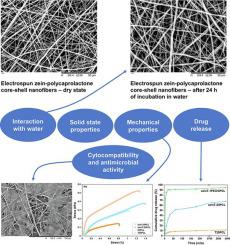International Journal of Pharmaceutics ( IF 5.3 ) Pub Date : 2022-05-10 , DOI: 10.1016/j.ijpharm.2022.121809 Alma Martin 1 , Jun Cai 2 , Anna-Lena Schaedel 2 , Mariena van der Plas 3 , Martin Malmsten 4 , Thomas Rades 2 , Andrea Heinz 2

|
In a previous study, we developed electrospun antimicrobial microfiber scaffolds for wound healing composed of a core of zein protein and a shell containing polyethylene oxide. While providing a promising platform for composite nanofiber design, the scaffolds showed low tensile strengths, insufficient water stability, as well as burst release of the antimicrobial drug tetracycline hydrochloride, properties which are not ideal for the use of the scaffolds as wound dressings. Therefore, the aim of the present study was to develop fibers with enhanced mechanical strength and water stability, also displaying sustained release of tetracycline hydrochloride. Zein was chosen as core material, while the shell was formed by the hydrophobic polymer polycaprolactone, either alone or in combination with polyethylene oxide. As compared to control fibers of pristine polycaprolactone, the zein-polycaprolactone fibers exhibited a reduced diameter and hydrophobicity, which is beneficial for cell attachment and wound closure. Such fibers also demonstrated sustained release of tetracycline hydrochloride, as well as water stability, ductility, high mechanical strength and fibroblast attachment, hence representing a step towards the development of biodegradable wound dressings with prolonged drug release, which can be left on the wound for a longer time.
中文翻译:

玉米蛋白-聚己内酯核-壳纳米纤维用于伤口愈合
在之前的一项研究中,我们开发了用于伤口愈合的静电纺丝抗菌微纤维支架,该支架由玉米醇溶蛋白核心和含有聚环氧乙烷的外壳组成。虽然为复合纳米纤维设计提供了一个有前途的平台,但支架显示出低拉伸强度、水稳定性不足以及抗菌药物盐酸四环素的突然释放,这些特性对于将支架用作伤口敷料并不理想。因此,本研究的目的是开发具有增强的机械强度和水稳定性的纤维,同时显示盐酸四环素的缓释。选择玉米醇溶蛋白作为核心材料,而外壳由疏水聚合物聚己内酯单独或与聚环氧乙烷组合形成。与原始聚己内酯的对照纤维相比,玉米醇溶蛋白-聚己内酯纤维表现出减小的直径和疏水性,这有利于细胞附着和伤口闭合。这种纤维还表现出盐酸四环素的持续释放,以及水稳定性、延展性、高机械强度和成纤维细胞附着性,因此代表了开发具有延长药物释放时间的可生物降解伤口敷料的一步,这种敷料可以留在伤口上一段时间。更长的时间。


















































 京公网安备 11010802027423号
京公网安备 11010802027423号